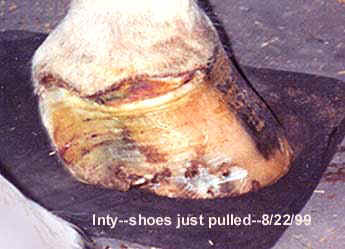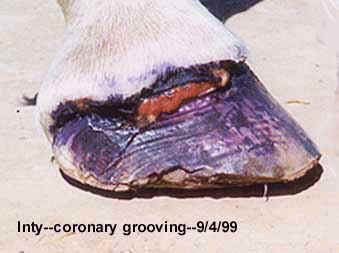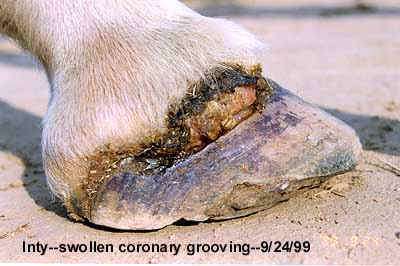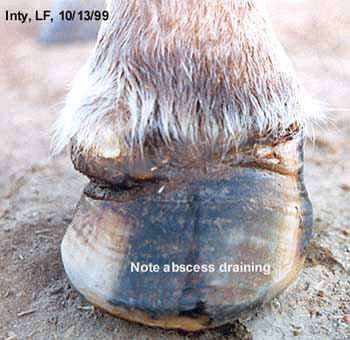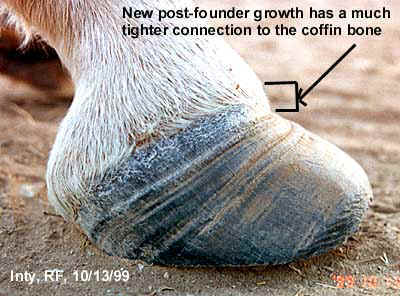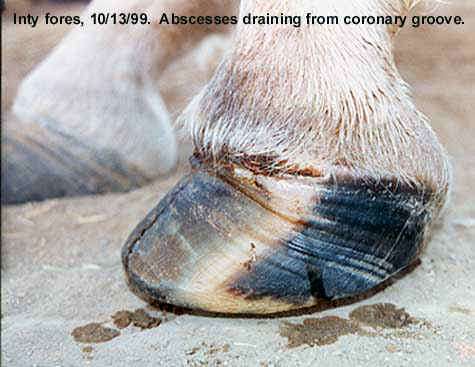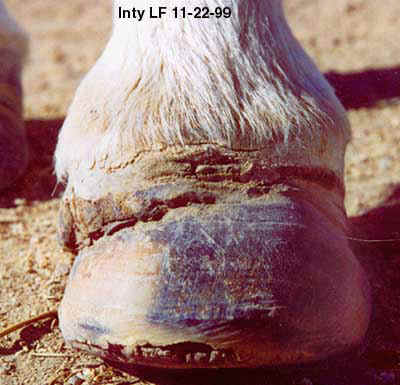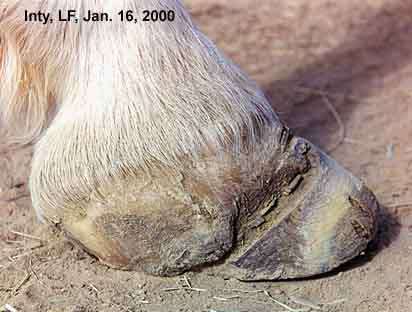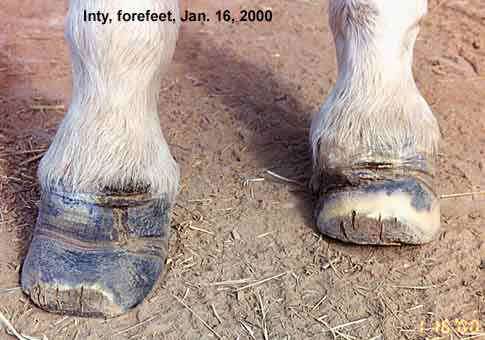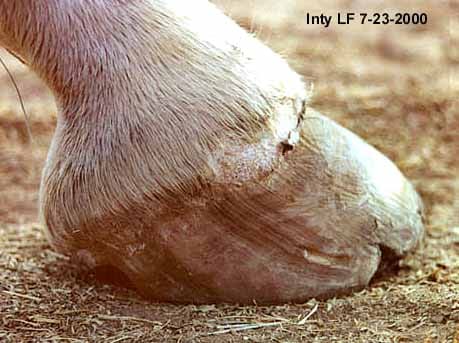Rubbing nitroglycerin ointment into the coronet band—restores circulation and removes toxins trapped in the laminae in 10-15 minutes. It is an effective tool for acute laminitis, but not to be used lightly, and it should be done by a vet. The sudden increase in circulation can cause significant pain. Some vets and an Arab horse farm recommended this to me, although I haven’t personally had any experience with it. Jaime heard good things about it, too. Only a temporary fix, though--you need to remove the underlying cause, which is improper hoof shape and a lack of hoof mechanism. I have correspondence with a German vet, who uses a number of other drugs in conjunction with nitro to reduce inflammation and enhance circulation. He feels nitro is inadequate by itself. (Correspondence re nitroglycerin ointment attached after the end of this article.)
There are many precautions needed when working with nitro. If you have low blood pressure, getting nitro on your hands can lower your blood pressure enough to make you faint. Also, if you do not keep the horse moving afterwards, suddenly increasing blood flow into the feet without having enough movement to help circulate the used blood back to the heart can result in inflammation, possibly leading to more rotation and/or shock. Stalling a horse after applying this is a really bad idea.
For more info on nitroglycerin ointment--
(article from web page of Hoofcare and Lameness Magazine)
http://www.thehorse.com/1097/step_by_step.html
Correspondence about nitroglycerin ointment
Still, the ideal way to increase circulation is mechanical (constant movement, frequent correct trims, and free living conditions), not chemicals applied topically.
My Amish shoeing stock maker, Christ M. Yoder, says he had great success with bleeding (!) a foundered horse. (Well, it would lower blood pressure...) In addition to the Amish using bleeding, I also have an account from Pat Coleby of gypsies using bleeding for acute founder. It is an idea that merits more investigation. It was still being recommended for the treatment of founder by the US Dept. of Agriculture as late as 1942. (Mott, LO, et al. Yearbook of Agriculture, USDA, 1942: 456)
Never use cortisone. Excess steroids can actually cause acute laminitis. Excess steroids mimic the high cortisone levels caused by pituitary adenoma, which increases susceptibility to laminitis. I have been hearing of cases where steroids have foundered horses.
I have heard of so many horses being given aggressive drug therapy, with as many as 5 or 6 drugs simultaneously. Many of these horses do not survive. Common drug combinations are: bute, banamine, ace, isoxuprene, lasix, antibiotics, etc. These horses are eating and drinking less and less, developing ulcers even inside their mouths, let alone their stomachs, and dehydrating. This is followed by either colic or kidney failure. Please don't succomb to this temptation! It seems that the most caring of owners are just trying to be really proactive, and give as many drugs as they can to help the horse. If you want to do something pro-active, reach for you farrier tools instead of those pills and shots. A correct trim will do him more good. So will another walk!
Deep Digital Flexor Tenotomy as a Treatment for Chronic Laminitis--DON'T DO IT!!!
For more info on the reasoning behind this procedure, Click HERE The general idea is that if the laminae holding the coffin bone up inside the hoof capsule are weak, surgically lengthening the deep digital flexor tendon will reduce the pull on the coffin bone that will otherwise tend to pull it away from the hoof capsule. In fact, I have seen the results of this surgery on one pony who had it only done on one foreleg. Because the root cause, heel pain, was not addressed by better hoof form, he just bunched his shoulder muscles up all the more and continued to be 'over at the knee' and rotated. Here are photos of a horse AFTER this procedure, posted on the naturalhorsetrim list archives:
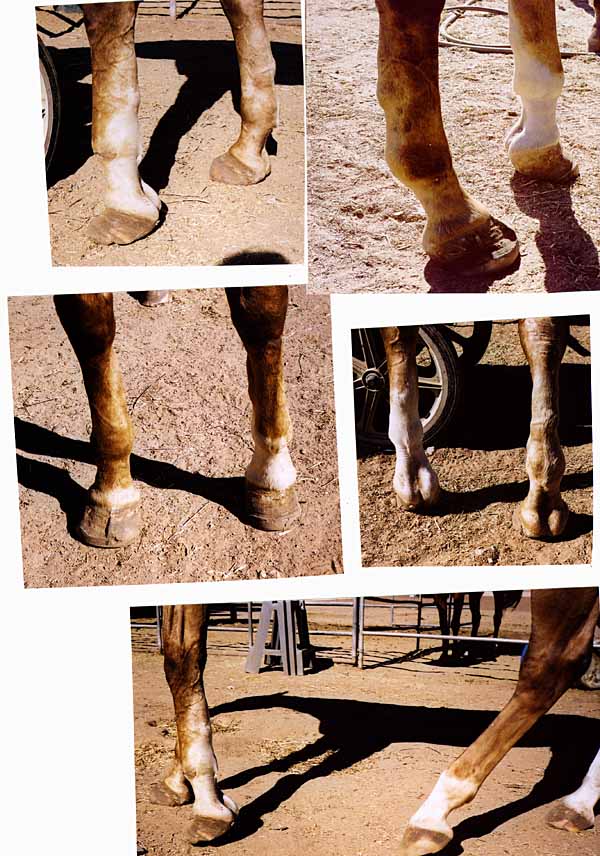
Heel pain from long, overlaid bars, and/or protruding frogs, must be addressed first, or your horse will remain 'over at the knee' despite the surgery. If his tendons have been surgically lengthened, he will just have to cramp his shoulder muscles up all the more to try and take weight off sore heels. Continued toe-walking to relieve heel pain will over-stress the laminae in the toe and promote more rotation.
Grooving and resections--Dr. Strasser feels these are an unnecessary mutiliation with possible complications. Many vets and farriers endorse resections and grooving, however. Bergy advocates "grooving" the feet for chronic laminitis. To quote "HoofTalk":
| "The dead tissue accumulating between the coffin bone and the forward hoof wall restricts blood flow, retarding hoof growth at the toe and causing the heel to grow faster. Hoof growth at the toe can be encouraged by grooving the outer hoof wall, restoring uniform enclosure of the coffin bone...If upon revisiting in two months [after the acute episode], evidence of a necrotic wedge is visible in the growth pattern, the author will groove the hoof and utilize the imported hoof care product." |
The hoof care product is the Reducine produced in Ireland, not what Farnam sells here. You apply to the coronet band 3x weekly to stimulate faster hoof growth. Dr. Strasser's take on this is that if you increase circulation via mechanical means--correct trimming and activity--using counter-irritant chemicals is both unnecessary and undesirable.
How Bergy grooves the feet:
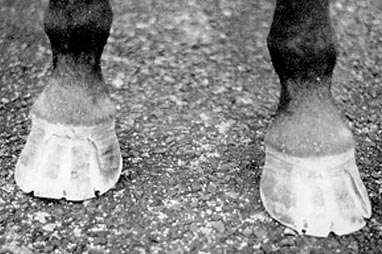
Refer back to Pollitt's corrosions earlier on my web page.
Grooving relieves pressure in the same areas the Pollitt images show
the circulation is the worst in a foundered foot.
In the wrong hands, these resections and groovings can get infected. The resection I had on Max at OSU in '93 had no such complications, but sometimes there are problems. I religiously kept his feet sterile and bandaged for 2 weeks.
The edges of the cuts can create pressure points and swelling as well. Or it is possible to groove too deeply.
In the case below, which turned out badly, the vertical grooves that Bergy does were not done, which may be part of the reason for the resulting swollen coronet bands.
|
A nightmarish experience with grooving and conventional treatment-- Inty foundered 5/24/99. Heartbar shoes were put on the same day. She was kept stalled constantly in a deeply bedded stall. On 4 butes a day for 3 months; 1st ten days also on ace and DMSO gel applied to coronet bands. Continued to deteriorate despite (or because?) of all this therapy. July--left foot rotated to 8 degrees and became to worse foot. 7/27/99--X-rays showed 8 degree rotation on both forefeet. 7/30/99--Coronary grooving done by vet who specialized in lamintis. Put on antibiotics for a month following the grooving. Immediate deterioration, and began to be down all the time. This vet recommended to not reset the heartbars, to avoid trauma to the hoof due to resetting the shoes, even though they were "due" (8 weeks) and the heels were already pretty high. The rationale for this grooving was to reduce pressure on the coronet band in the toe area from the rotated toe levering into it by grooving. What is appalling is that I believe the whole thing could have been accomplished much cheaper, easier and less traumatically by simply lowering the heels and backing up the toes. Backing up the toes so they were not actually touching the ground center front could have prevented the top of the toe wall from levering into the coronet, and lowering the heels would shift weight and pressure off the toes. The edges of this grooving impaired circulation and created a lot of swelling--see photos:
8/22/99-Frank Orza first pulled the shoes, and prior to trimming
9/4/99--Beginning to work on lowering heels. Grooving not healing.
9-24-99--Grooving causing swelling....corium prolapse. Yvonne had been reading my site for a while, but had been afraid to take the plunge. However, the conventional treatment was obviously not working, and the mare was down more and more after the grooving. She ordered Jaime Jackson's and Dr. Strasser's books in August. Reading these prompted her to turn the mare out to pasture 8/19/99. Constant movement in the field resulted in immediate reduction in soreness. Began weaning off bute as well. As the trim got closer to the Strasser trim and the horse kept moving, the mare was up more and more, and feeling progressively better. End of September--her husband flew up to Canada to learn the Strasser trim from Sabine Kells first-hand. The trim has been improved, and Inty is doing better all the time, moving better. Although there have been ouchy periods of abscessing, the general trend has been up. What is interesting is that although both feet were equally rotated, the one with the grooving is improving a lot slower than the one that wasn't grooved.
Left fore, October 13, 1999--still swollen, abscesses draining
Right fore, which had the same amount of rotation, healing faster.
Abscesses draining from coronary groove, October 13, 1999
Progress at last! Swelling starting to go down, (Application of propulis tincture speeded healing of proud flesh.) Updated photos of Inty, from January 16, 2000:
At last! Swelling down on the left fore, where the grooving had been done. The new toe wall growing in above the founder ridge shows that the laminitic attachment is tighter. However, please note that the toe is growing much faster on the right side, which had not been grooved.
Inty, LF, July 23, 2000--more progress! As of August, 2000, Inty is sound on all her feet except the LF, which continues to be sore off and on. As I get updated photos, I will add them. Yvonne Welz can be reached at editor@thehorseshoof.com Eventually, Inty was put down. |
